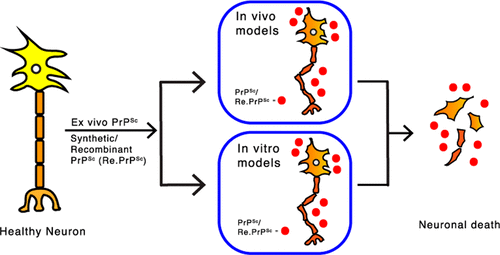当前位置:
X-MOL 学术
›
ACS Chem. Neurosci.
›
论文详情
Our official English website, www.x-mol.net, welcomes your
feedback! (Note: you will need to create a separate account there.)
Acute Neurotoxicity Models of Prion Disease
ACS Chemical Neuroscience ( IF 4.1 ) Pub Date : 2018-02-02 00:00:00 , DOI: 10.1021/acschemneuro.7b00517 A. M. T. Islam , P. A. Adlard , D. I. Finkelstein , V. Lewis , S. Biggi 1 , E. Biasini 1 , S. J. Collins
ACS Chemical Neuroscience ( IF 4.1 ) Pub Date : 2018-02-02 00:00:00 , DOI: 10.1021/acschemneuro.7b00517 A. M. T. Islam , P. A. Adlard , D. I. Finkelstein , V. Lewis , S. Biggi 1 , E. Biasini 1 , S. J. Collins
Affiliation

|
Prion diseases are phenotypically diverse, transmissible, neurodegenerative disorders affecting both animals and humans. Misfolding of the normal prion protein (PrPC) into disease-associated conformers (PrPSc) is considered the critical etiological event underpinning prion diseases, with such misfolded isoforms linked to both disease transmission and neurotoxicity. Although important advances in our understanding of prion biology and pathogenesis have occurred over the last 3–4 decades, many fundamental questions remain to be resolved, including consensus regarding the principal pathways subserving neuronal dysfunction, as well as detailed biophysical characterization of PrPSc species transmitting disease and/or directly associated with neurotoxicity. In vivo and in vitro models have been, and remain, critical to furthering our understanding across many aspects of prion disease patho-biology. Prion animal models are arguably the most authentic in vivo models of neurodegeneration that exist and have provided valuable and multifarious insights into pathogenesis; however, they are expensive and time-consuming, and it can be problematic to clearly discern evidence of direct PrPSc neurotoxicity in the overall context of pathogenesis. In vitro models, in contrast, generally offer greater tractability and appear more suited to assessments of direct acute neurotoxicity but have until recently been relatively simplistic, and overall there remains a relative paucity of validated, biologically relevant models with heightened reliability as far as translational insights, contributing to difficulties in redressing our knowledge gaps in prion disease pathogenesis. In this review, we provide an overview of the spectrum and methodological diversity of in vivo and in vitro models of prion acute toxicity, as well as the pathogenic insights gained from these studies.
中文翻译:

Pri病毒急性神经毒性模型
on病毒疾病是表型多样,可传播的神经退行性疾病,会影响动物和人类。正常病毒蛋白(PrP C)错折叠为疾病相关构象异构体(PrP Sc)被认为是病毒疾病的关键病因,这些错折叠的同工型与疾病传播和神经毒性有关。尽管在过去的3-4年中,我们对病毒生物学和发病机理的理解取得了重要进展,但仍有许多基本问题有待解决,包括关于保护神经元功能障碍的主要途径的共识,以及PrP Sc的详细生物物理表征传播疾病和/或直接与神经毒性有关的物种。体内和体外模型一直并且仍然是进一步增进我们对病毒疾病病理生物学许多方面的了解的关键。on病毒动物模型可以说是存在的最真实的神经退行性体内模型,并提供了对发病机理的宝贵而广泛的见解。然而,它们昂贵且耗时,并且清楚地辨别直接PrP Sc的证据可能会成问题。在整个发病机制中具有神经毒性。相比之下,体外模型通常具有更高的易处理性,并且似乎更适合直接急性神经毒性的评估,但直到最近相对简单化,并且总体而言,相对而言,经过验证的,生物学相关的模型相对缺乏,就翻译的见解而言,它们具有更高的可靠性。 ,在解决我们在病毒病发病机理方面的知识空白时遇到了困难。在这篇综述中,我们概述了病毒急性毒性的体内和体外模型的光谱和方法学多样性,以及从这些研究中获得的病原学见解。
更新日期:2018-02-02
中文翻译:

Pri病毒急性神经毒性模型
on病毒疾病是表型多样,可传播的神经退行性疾病,会影响动物和人类。正常病毒蛋白(PrP C)错折叠为疾病相关构象异构体(PrP Sc)被认为是病毒疾病的关键病因,这些错折叠的同工型与疾病传播和神经毒性有关。尽管在过去的3-4年中,我们对病毒生物学和发病机理的理解取得了重要进展,但仍有许多基本问题有待解决,包括关于保护神经元功能障碍的主要途径的共识,以及PrP Sc的详细生物物理表征传播疾病和/或直接与神经毒性有关的物种。体内和体外模型一直并且仍然是进一步增进我们对病毒疾病病理生物学许多方面的了解的关键。on病毒动物模型可以说是存在的最真实的神经退行性体内模型,并提供了对发病机理的宝贵而广泛的见解。然而,它们昂贵且耗时,并且清楚地辨别直接PrP Sc的证据可能会成问题。在整个发病机制中具有神经毒性。相比之下,体外模型通常具有更高的易处理性,并且似乎更适合直接急性神经毒性的评估,但直到最近相对简单化,并且总体而言,相对而言,经过验证的,生物学相关的模型相对缺乏,就翻译的见解而言,它们具有更高的可靠性。 ,在解决我们在病毒病发病机理方面的知识空白时遇到了困难。在这篇综述中,我们概述了病毒急性毒性的体内和体外模型的光谱和方法学多样性,以及从这些研究中获得的病原学见解。











































 京公网安备 11010802027423号
京公网安备 11010802027423号